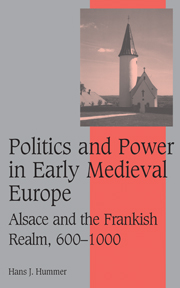Book contents
- Frontmatter
- Contents
- List of maps and tables
- Preface and acknowledgements
- List of abbreviations
- INTRODUCTION
- 1 THE LATE MEROVINGIAN ORDER
- 2 CONQUEST AND CONTINUITY
- 3 THE CAROLINGIANS AND ECCLESIASTICAL PROPERTY
- 4 REACTION AND RESISTANCE
- 5 THE POLITICS OF OLD GERMAN
- 6 IMPERIAL UNITY AND REGIONAL POWER
- 7 THE LATE CAROLINGIAN ORDER
- 8 THE TENTH-CENTURY TRANSFORMATION
- 9 CONCLUSIONS
- Appendix: Records of the dispute between Rodoin and Gebahart and the monastery of Weissenburg
- Bibliography
- Index
- Cambridge Studies in Medieval Life and Thought Fourth series
8 - THE TENTH-CENTURY TRANSFORMATION
Published online by Cambridge University Press: 16 July 2009
- Frontmatter
- Contents
- List of maps and tables
- Preface and acknowledgements
- List of abbreviations
- INTRODUCTION
- 1 THE LATE MEROVINGIAN ORDER
- 2 CONQUEST AND CONTINUITY
- 3 THE CAROLINGIANS AND ECCLESIASTICAL PROPERTY
- 4 REACTION AND RESISTANCE
- 5 THE POLITICS OF OLD GERMAN
- 6 IMPERIAL UNITY AND REGIONAL POWER
- 7 THE LATE CAROLINGIAN ORDER
- 8 THE TENTH-CENTURY TRANSFORMATION
- 9 CONCLUSIONS
- Appendix: Records of the dispute between Rodoin and Gebahart and the monastery of Weissenburg
- Bibliography
- Index
- Cambridge Studies in Medieval Life and Thought Fourth series
Summary
The political order in early medieval Alsace was transformed in the tenth century, when monasteries began to emancipate themselves from lay domination. As was the case elsewhere in east Francia, and in Burgundy beyond the east Frankish kingdom, monastic reform in Alsace progressed with the acquiescence of the lay aristocracy. Later, in the eleventh century, the reform popes were able to build upon these impulses and harness lay piety and unrest to redefine the relationship between royal and ecclesiastical authority. Meanwhile, in the tenth century, monastic reform in the Vosges – indeed in many other regions of east Francia – was profoundly shaped by a newly assertive royal authority administered by the Ottonian kings, the dynasty that succeeded the Carolingians in east Francia.
The energy of the Ottonian dynasty was not apparent from its inception under Henry, the duke in Saxony, who succeeded the reputedly ill-fated reign of the Franconian duke Conrad, who had succeeded the last Carolingian king in the east, Louis the Child. Henry did successfully organize defences against Magyar raids and fashioned a system of cooperative rule with the by now entrenched regional dukes. For much of his reign, Henry left Alsace to its own devices. Partly, this was a logical outgrowth of the horizontal rulership he fostered with the dukes, which in Alsace meant deference to Duke Burchard of Swabia, whose sphere of influence encompassed the southwestern sector of the east Frankish realm.
- Type
- Chapter
- Information
- Politics and Power in Early Medieval EuropeAlsace and the Frankish Realm, 600–1000, pp. 227 - 249Publisher: Cambridge University PressPrint publication year: 2006



